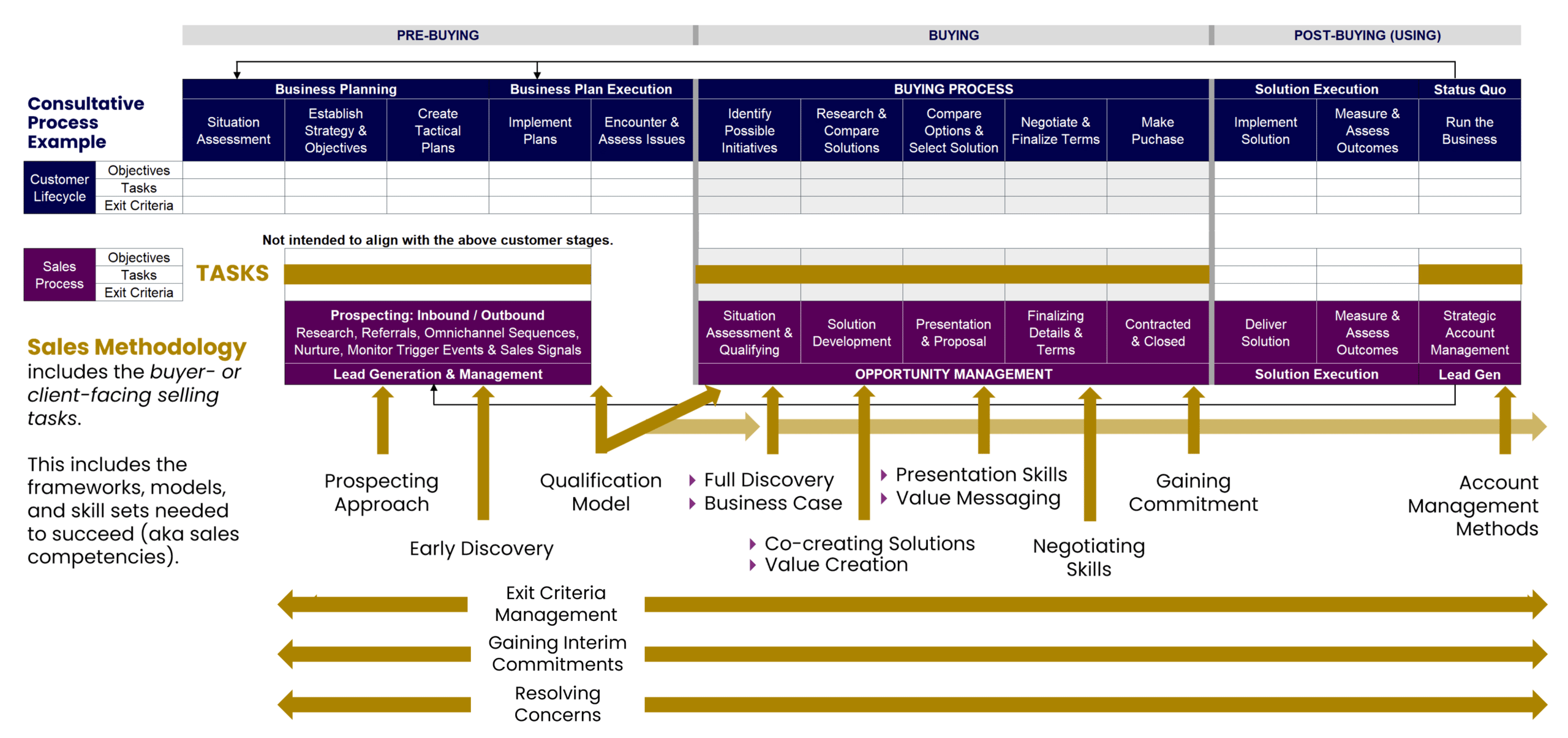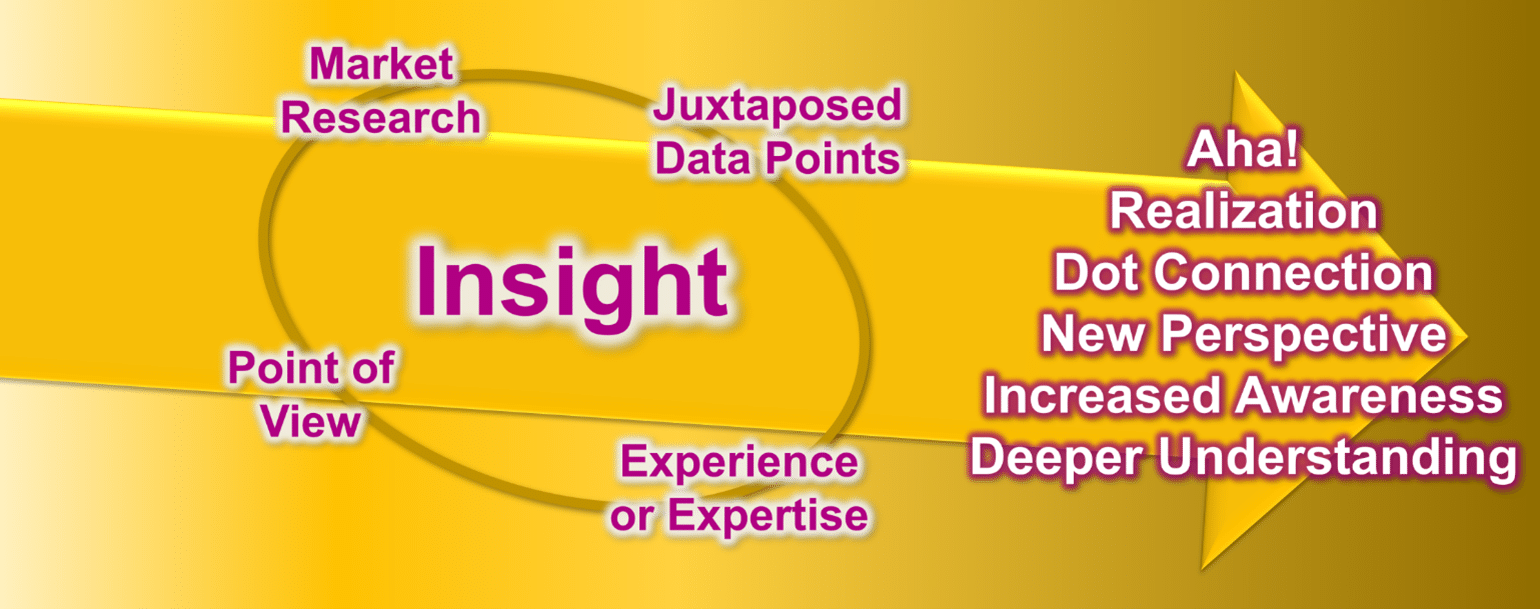Many distributors are looking for ways to drive growth in a softer market. One effective approach is to layer insight selling — providing value to customers with relevant data and expertise— into their existing sales methodology. This article will explore what sales methodology is, the importance of a buyer-centric approach and how to effectively integrate insight selling to drive better outcomes.
This assumes, of course, that a formal sales methodology is in place. When I talk about this with distributors, it always reminds me of how my dear ol’ mom, Myra, used to make fun of the highly advertised get-rich-quick schemes of her day. “Yeah,” she’d say, “How do you make a billion dollars? First, take your millions and …” and then she’d laugh.
Insight sales is not a get-rich-quick shortcut, so before we get cover it, let’s talk about sales methodology.
Understanding Sales Methodology

The Importance of a Buyer-Centric Sales Methodology
A modern sales methodology must be buyer-centric, focusing on understanding and addressing the needs and challenges of the buyer. This approach must be modern, based on how today’s buyers want to buy, as well as consultative, value-focused and outcome-oriented. The methodology should be:
Aligned with the customer lifecycle: The sales methodology should map to the entire customer lifecycle, from pre-buying (status quo/running their business) to initial awareness and consideration, to purchase, implementation and ongoing support. This ensures that the sales process is relevant and valuable at every stage of the buyer’s journey, reducing friction, enhancing the buying and customer experience and fostering loyal, long-term relationships.
Problem-focused: Rather than being seller-centric or product-centric, the methodology should focus on the problems you solve for buyers and customers. Problems in this context might include challenges to resolve or strategic opportunities to capitalize on, with a limited window. By using this sort of messaging, you demonstrate relevance, generate AIR (Awareness, Interest, Relationship), and show a deep understanding of the buyer’s needs, positioning your solution as essential.
Consultative: This means engaging with buyers to understand their needs and provide the best possible tailored solutions to achieve what matters most to them. This approach builds trust and positions the seller as a valuable advisor. It involves asking insightful questions, actively listening and offering expert advice that aligns with the buyer’s goals and challenges.
Value-focused: Value sellers highlight the unique value that the product or service brings to the buyer, from their perspective, rather than just its generic features and benefits. This means articulating how your solution can improve the buyer’s business, reduce costs, increase efficiency or provide other tangible benefits that matter to them. Expert value sellers are “multilingual,” meaning they can describe solutions in diverse ways, based on the value it provides to the buyer with whom they’re speaking.
Outcome-oriented: Outcome sellers focus on the results that the buyer can achieve by using the product or service, which helps in aligning the sales process with the buyer’s goals. This involves setting clear expectations for the outcomes and benefits the buyer will experience and demonstrating how your solution will help them achieve their desired results.
Managing buying process exit criteria: The methodology should include clear exit criteria for each stage of the buying process. This means defining specific milestones or conditions that must be met before moving to the next stage, ensuring that both the buyer and seller are aligned and that the sales process progresses smoothly and efficiently. Most sellers, if they do this part at all, attempt to satisfy the general exit criteria for the stage they’re in. Expert sellers uncover, clarify, satisfy and confirm satisfaction of the exit criteria for each individual influencer and decision maker, per stage.
Laying the Foundation for Insight Selling
Before layering insight selling into their approach effectively, distributor sales forces must have this solid foundation in place. You can’t build a mansion on a foundation of mud. If you have gaps, it will be difficult to communicate at a more advanced level with insights. Your adoption rates will be low, and your effectiveness will be hampered. In fact, insight selling done poorly can do more harm than good.
The Risks of Poorly Executed Insight Selling
Misalignment with buyer needs: Without a solid foundation, your sales team may struggle to understand and address the specific needs and challenges of buyers. This can lead to irrelevant or generic insights that fail to resonate with customers.
Reduced credibility: Insight selling requires a deep understanding of the buyer’s industry and business. If your sales team lacks the necessary knowledge and expertise, they risk losing credibility and trust with potential customers.
Ineffective communication: Advanced insights must be communicated clearly and persuasively. Without a solid foundation in basic sales skills, your team may struggle to convey insights effectively, leading to confusion and disengagement.
Lower adoption rates: If your sales team is not fully trained and confident in your foundational methodology, they may be hesitant to adopt and implement insight selling techniques. This can result in inconsistent application and lower overall effectiveness.
Potential harm to relationships: Poorly executed insight selling can damage relationships with customers. If insights are perceived as irrelevant or intrusive, it can lead to frustration and a loss of trust.
It may seem as if I’m now trying to talk you out of adopting an insight selling approach. Nothing could be further from the truth. I am merely cautioning you that it must be done well, with a sales force who excels with the type of methodology I’ve described above.
So, assess your sales force and current methodology usage objectively. If you close your sales competency gaps first, you will improve both skill levels and sales results. Then, when you layer insight selling, you can lift results again.
What Exactly is Insight Selling?

Insight selling is a strategic approach that goes beyond traditional sales techniques. It is not a full-cycle sales methodology but rather a particular method that can be layered and used when appropriate. It involves providing data, research, expertise and experience tailored to the customer’s specific needs, based on expert knowledge, industry insights and a deep understanding of the customer’s business challenges and ideal solutions.
Often, insight selling introduces the buyer to issues they’re either not currently thinking about or don’t consider urgent. The goal of insight selling is to create an “Aha Moment” for the buyer, generating awareness of a problem and sparking interest in exploring how to resolve it. It’s not about pushing your product — it’s about providing context that will lead them to recognizing an issue you can help them address.
I often say that insights are designed to generate Aha Moments, and Aha Moments are like earthquakes. They vary in intensity, right? Some topple buildings; others just rattle your china. But both get your attention. Not every Aha Moment will be groundbreaking. The purpose of sharing insights isn’t just to impress; it’s to foster and deepen the ongoing conversation, opening new possibilities to explore with your client.
Key Elements of Insight Selling
Research and prepare: Thoroughly research the buyer’s industry, market trends, and specific business challenges. This preparation allows you to provide relevant and impactful insights.
Tailor insights: Customize your insights to address the unique needs and pain points of each buyer. Generic information won’t create the same impact as tailored, relevant insights. You can, however, create reusable libraries of insights by vertical industry and customer type, which can be used as “starter insights” to personalize.
Create “Aha Moments”: Use your insights to highlight issues or opportunities the buyer may not have considered. These moments of realization can shift the buyer’s perspective and open the door to deeper discussions.
Build trust and credibility: By consistently providing valuable insights, you position yourself as a trusted advisor. This builds credibility and strengthens your relationship with the buyer.
Foster ongoing dialogue: The goal of insight selling is to keep the conversation going. Use insights to continually engage the buyer, explore new possibilities and collaboratively find solutions.
Benefits of Insight Selling
Differentiation: Insight selling sets you apart from competitors who may rely solely on traditional sales techniques.
Deeper engagement: By addressing the buyer’s specific challenges, you create more meaningful and engaging interactions.
Increased value perception: Providing valuable insights enhances the perceived value of your solution, making it more attractive to the buyer.
Stronger relationships: Insight selling fosters trust and positions you as a partner invested in the buyer’s success.
By integrating insight selling into your sales approach, you can create more impactful and meaningful engagements with your clients, ultimately driving better outcomes for both parties.
Integrating Insight Selling into Your Sales Methodology

Research and Understand the Market & Buyer
In-depth market research: Invest time in researching the target market, including industry trends, competitive landscape, research data and economic factors. This helps you understand the broader context in which your buyers operate.
In-depth account research: Include any transactional sales data you have for the customer and their purchase patterns, which they may not be as familiar with. If you have data on purchase patterns of others in their vertical industry or competitive set, you might find cross-sell opportunities that could benefit them through one-stop shopping or preferred volume pricing.
Buyer persona development: Create detailed buyer personas that capture the specific COIN-OP (Challenges, Opportunities, Impacts, Needs, Outcomes and Priorities) to ensure that your insights are relevant and impactful.
Customer journey mapping: Map out the customer journey to identify key touchpoints and opportunities where insights can add value. This helps in tailoring your approach to various stages of the buying process.
Provide Valuable Insights
Leverage data and analytics: Use data and analytics to uncover trends, patterns, and opportunities that are relevant to your buyers. This can include market reports, customer feedback, and performance metrics.
Highlight market trends: Offer unique perspectives on market trends that are relevant to the buyer. This positions you as a knowledgeable advisor who understands the industry landscape.
Share case studies and success stories: Use examples from other clients you’ve helped to illustrate the impact of your solutions. This provides social proof and demonstrates your expertise.
Create “Aha Moments”
Identify hidden issues: Use your insights to highlight challenges or opportunities the buyer may not have considered yet (or considered their impact). These moments of realization can shift the buyer’s perspective and open the door to deeper discussions.
Deliver your insight message: Follow one of these formats:
- Describe the challenge or opportunity and check for relevance
- Share the insight (data, research, expertise, experience) and check for relevance
- Share outcomes you’ve delivered and check for relevance
- Describe the solutions and check for interest to explore further
Juxtapose data points to create tension: By presenting contrasting data points, you can create a sense of surprise or tension that captures attention and drives engagement. This technique leverages the unexpected to highlight insights, making your message more impactful and memorable. Here are two examples, one from distribution and one from my world of sales performance improvement:
Example 1: “According to a study we conducted in partnership with a client using our both our PC4X pneumatic cylinders and the CelSor brand you are currently using, the CelSors required 15% more maintenance over a three-year period and had a lifespan that was 22% shorter. In this client, with units operating in the same environments, the PC4X reduced operational downtime by 30% and comes with a 25% longer warranty.” (In this case, the seller could follow-up by adding, “In their business, over a three-year period, the difference in operating costs resulted in just over $3MM. With your larger footprint, I’ve estimated your savings to be about $4.5MM, despite an 8% higher cost per unit. If this seems worth exploring, I’d like to validate the numbers we used with you, to develop a business case you can socialize. Does this make sense to explore further?”)
Example 2: “According to CSO Insights, 67% of VPs of Sales rated “New Account Acquisition” as their top sales objective this year. Unfortunately, 65% of those same sales leaders rate their sales force as “Needing Improvement” in lead generation.
Note: Keep in mind, these are just the presentation of the data or insights, not the entire dialogue.
Use Storytelling Techniques: Craft compelling narratives that resonate with the buyer’s challenges and aspirations. Storytelling can make your insights more relatable and memorable. Incorporating ethos (credibility), pathos (emotions), and logos (logic) can make your stories more compelling. First, check yourself to make sure you’re operating in your buyer’s best interests, If you are, your influence and persuasion efforts will be ethical.
Engage with Visuals: Use visuals such as charts, graphs, and infographics to present your insights in a clear and engaging way. Visuals can help simplify complex information and make it more digestible.
Position as a Trusted Advisor
Consistent value delivery: By consistently providing valuable insights, you position yourself as a trusted advisor. This builds credibility and strengthens your relationship with the buyer.
Active listening and empathy: Show genuine interest in the buyer’s challenges and goals. Active listening and empathy help build trust and demonstrate that you are invested in their success.
Tailored solutions: Offer tailored solutions that address the buyer’s specific needs and pain points. This reinforces your role as a valuable advisor who provides relevant and practical advice.
Foster Ongoing Dialogue
Continuous engagement: Use insights to continually engage the buyer, explore new possibilities and collaboratively find solutions. This keeps the conversation going and builds a long-term relationship.
Regular check-ins: Schedule regular check-ins with your buyers to discuss their evolving needs and provide new insights. This shows that you are proactive and committed to their success. This could include a periodic Customer Value Review or Quarterly Business Review.
Feedback loop: Encourage feedback from your buyers to understand how your insights are being received and where you can improve. This helps in refining your approach and delivering even more value.
By integrating these steps into your sales methodology, you can effectively layer insight selling into your approach. This will help you create more impactful and meaningful engagements with your clients, ultimately driving better outcomes for both parties.
Closing Thoughts
Integrating insight selling into a distributor’s sales methodology can significantly enhance a distribution sales force’s ability to engage with buyers, build trust and drive better outcomes. By focusing on a buyer-centric approach and leveraging insights, distributors can differentiate themselves in the market and achieve greater success.
Insight selling is not just a technique but a mindset shift that requires a solid foundation, continuous learning and a commitment to understanding and addressing the unique needs of each buyer. By investing in thorough research, tailoring insights and fostering ongoing dialogue, distributors can create meaningful and impactful engagements that resonate with their clients.
Moreover, the benefits of insight selling extend beyond immediate sales. It positions distributors as trusted advisors, fosters long-term relationships and enhances the overall customer experience. This approach not only drives sales but also builds a loyal customer base that values the distributor’s expertise and partnership.
In a competitive or softer market, the ability to provide valuable insights and create Aha Moments can be a game-changer. Distributors who embrace this approach will not only stand out from their competitors but also drive sustainable growth and success.
By integrating these strategies into your sales methodology, you can transform your sales approach, deliver exceptional value to your clients and achieve lasting success in the ever-evolving marketplace.
Additional Reading:
- What’s Changed about Consultative Selling?
- A Comprehensive Guide to Using Competency Assessments to Bridge Skill Gaps
- Why Selling is a Joke (Article on Insight Selling)
- Enable Your Sellers to GTM More Effectively
Mike Kunkle is an internationally recognized expert on sales enablement, sales effectiveness, sales training, sales coaching, sales management, and sales transformations.
He’s spent over 30 years helping companies drive dramatic revenue growth through best-in-class enablement strategies and proven effective sales systems.
Mike is the founder of Transforming Sales Results, LLC where he designs sales training, delivers workshops, and helps clients improve sales results through a variety of sales effectiveness practices and advisory services.
He collaborated to develop SPARXiQ’s Modern Sales Foundations™ curriculum and authored their Sales Coaching Excellence™ and Sales Management Foundations™ courses.
Mike's book, The Building Blocks of Sales Enablement, is available on Amazon, with others coming soon in 2026, starting with The CoNavigator Method for B2B Selling.

